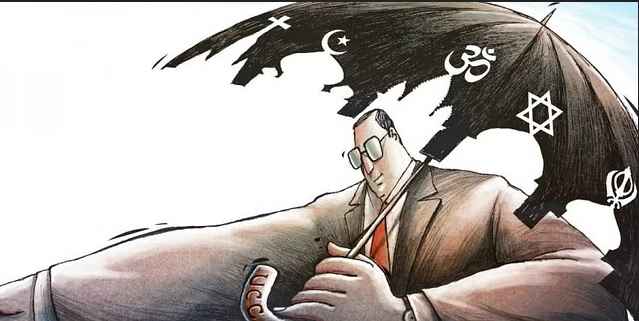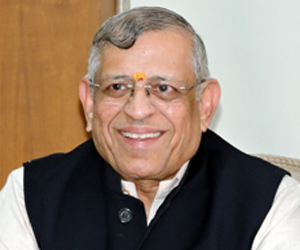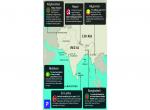The BJP’s articulators’ understanding of the UCC doesn’t seem to go to the deep, sordid historical origins of the UCC.
After the 1937 Act was passed, the Muslim League emerged as a Muslim mass party and began challenging the unchallenged Gandhi-led Congress, which had till then total mobilising power over the Indian masses. The 1937 Act triggered powerful forces of Islamic religious and communal passions outside the Congress's influence. As the British and the League had intended, the Act helped the massive shift of the Muslims from the Gandhi-led Congress. The shift was so huge and so swift that even the League, which had till then thought of a federal government for Hindus and Muslims with separation of powers, suddenly shifted gears and asked for partition. The 1937 Act was passed in October 1937 and within just two-and-a-half years, in March 1940, Jinnah passed the Lahore partition resolution.
Article 44 as reaction to the 1937 Act
The UCC will not be written on a clean slate, it will be overwritten on the 1937 Shariat Act. What divided the Hindu and Muslim relations by a jhatka and eventually India itself, was the 1937 Act. The partition could not bridge the divide, and the continuance of the 1937 Act post Independence continues to make the Hindu-Muslim relations drift towards a greater split. The UCC is an attempt to arrest that drift. The BJP’s response to the Congress charge that the UCC divides is, “Look at the Constitution, it says pass the UCC.” This is a poor response given the seriousness of the UCC to arrest the drift caused by the 1937 Act. The BJP’s articulators’ understanding of the UCC doesn’t seem to go to the deep, sordid historical origins of the UCC.
They do not seem to ask themselves the most obvious question — why did the Founding Fathers of the Constitution engage in strenuous discourse on the need for a Uniform Civil Code for India, which was after all within the legislative power of the Parliament? Had the 1937 Act not been passed and subsisted, the Constituent Assembly would not have wasted its time on the UCC. They could not allow a separate religious law, that too a law that divided India, to subsist. Any keen student of the history of the idea of the UCC in India would have known that the very thought of the UCC in the Constituent Assembly was clearly to undo the 1937 Shariat Act. The trigger for Article 44 mandating UCC under the Directive Principles was the 1937 Act, which divided India. The Founding Fathers did not want to leave it to the political discretion of the lawmakers later to pass or not to pass the UCC, but made it their constitutional duty. The BJP should be pointing to the 1937 Act as the cause that split India and that was why the Founding Fathers had to mandate the UCC as a stitch on the split. The BJP should be charging those who ruled the country for 70 years with having kept the split and wound open, which made Hindu-Muslim relations deteriorate instead of improve in secular India. If the BJP can’t tell the nation about the historical background of the UCC, which is the 1937 Act, why will the detractors of the UCC not ask what is the need for a Uniform Civil Code now when there are scores of other problems facing the nation?
Ambedkar’s challenge to Muslim League
The man who fought the case for the UCC in the Constituent Assembly was Dr B R Ambedkar. He lambasted the League members who argued in the Constituent Assembly against a common civil code saying Sharia was immutable for Muslims. He challenged them to deny that up to 1935, the North-West Frontier Province followed not the Sharia Law, but the Hindu Law, and up to 1937 in the rest of India, the United Provinces, the Central Provinces and Bombay, Muslims were largely governed by the Hindu Law in matters of succession. He cited that the Muslims in North Malabar were till that day following the Hindu Marumakkathayam (matrilineal) law. He concluded that no Muslim could say that the framers of the idea of a common civil code had done great violence to the sentiments of the Muslim community. Here are the details of the common bases of civil code among Hindus and Muslims which Dr Ambedkar spoke about.
Common civil law base of Hindu-Muslim society till October 1937
Go back to 1937. From Kerala to UP, from Bengal to North-West Province, whether it was the Hindu-ruled Ajmer-Merwara or Muslim-ruled Awad (Ayodhya), the rules of Inheritance, Succession, Adoption, or Wills were common for Hindus and Muslims. See the list.
In Kerala, the local Hindu law of Marumakkathayam prevailed over the Sharia among Moplah Muslims. In the succession to Tarawad in Malabar in Kerala, in Muslim families that followed Hindu customs, the Sharia was not applied.
In Punjab and the North-Western Province, now part of Pakistan, local Hindu customs prevailed over the Sharia. In Punjab, the heart of today’s Pakistan, the Hindu custom of allowing widows life estate in property prevailed over the Sharia that give her an absolute share. The customary law of East and West Punjab did not recognise the Sharia on Iddat, which provided for a divorced wife’s maintenance only for three months.
In Oudh (Ayodhya) — Muslim-ruled province till 1856 — the custom among the Muslims for the widows to take a life interest as per Hindu law prevailed over the Sharia that gave her specific, absolute share. In East and West Punjab, the custom of adoption prevalent among the Muslims that was contrary to the Sharia, was recognised by courts. The custom of writing Wills among the Muslims in East and West Punjab, which was contrary to the Sharia, too, was recognised by courts. In East Punjab, customs having the force of law were expressly allowed to prevail over the Shariat.
The Oudh Estates Act passed by Muslim rulers expressly exempted Muslims from the application of the Sharia. The Nawab of Oudh legislated local customs to prevail over the Sharia, as in East Punjab. It was identical in Ajmer-Merwara also. In Madhya Pradesh, too, local customs conflicting with the Sharia prevailed. Kambojis of Malerkotla state who were predominantly agricultural, were governed by local custom and not the Sharia in matters of inheritance.
When a large section of people converted from Hinduism to Islam, like the Kutchi Memons and the Khojas, they continued to be governed by Hindu laws. The same principle of Hindu law, as in the case of Memons and the Khojas, was applied to the Sunni Bohras and Molisalam Giriasias in Gujarat. Halai Memons, like the Kutchi Memons, were governed by Hindu law.
In Madras province, courts refused to apply the Sharia principle that mandated Muslims to sell their properties only to Muslims. In the Presidency towns of Calcutta, Madras, and Bombay, local Hindu customs prevailed over the Shariat. In the mofussil areas of Madras, local customs and usages were allowed to prevail over the Shariat.
An interesting tailpiece. Despite the Shariat Act 1937, the Muslims of Cooch Behar were governed only by the Hindu law till, believe it, as recently as July 1, 1980. Only from that date did the government of West Bengal notify the application of the Shariat Act.
Can anyone deny that the aim of the 1937 Act was to cut off the umbilical links that existed between the Hindus and the converts?
Economic integration, social diversity
It was this commonality between Hindus and converted Muslims at the local levels that made them feel like each other was the target of the 1937 Act. The Islamic Sharia consists of two broad aspects. One, the religious and cultural part; and two, the economic part. That part of Sharia which consisted of marriage, divorce and other cultural and social aspects was followed by the converted Muslims even before 1937. So, cultural diversity that enabled the converts to follow their own religious rules existed even before 1937. But the second part, the economic part, consisted of property rights and inheritance rules. As in almost the whole of India, local Hindu customs and usage laws of property and property rights were common to Hindus and Muslims till 1937, which acted as a powerful social and economic link and kept the converted Muslims integrated with their ancestral Hindu society. The idea behind the 1937 Act besides giving separate and formal communal and religious identity to the Muslims, was psychologically to snap the common rules of property and property rights. The strategy behind the Shariat Act 1937 was to break that societal bond. The 1937 Act turned two brothers with differences into enemies without a common base in just under a decade. See the most powerful example of how this transformation worked.
1937 Act turned brothers into enemies
Jinnah belonged to the Khoja Muslim community, also known as Ismailis. Who were Khojas? Even as late as just a few decades before Jinnah sounded the Islamic partition bugle, the Holy Book of the Khojas, was not the Quran but Dashavatara. In Dashavatara, nine Avatars up to Krishna were common between Khoja Muslims and Hindus. Only the 10th Avatar is different. The tenth Avatar for the Khojas was Ali, the son-in-law of Prophet Mohammed. In their work, The Aga Khan Case: Religion and Identity in Colonial India [p55] Purohit, Teena (2001) citing the famous Aga Khan succession case [1866] in the Mumbai High Court confirm that fact. In Dashavatara, part of the Ismaili devotional hymns known as Ginans was the work of Pir Sadruddin, founder of the Khojas and descendent of Prophet’s son-in-law, Ali. This was cited as Aga Khan’s previous connection with the Prophet through Ali Pir Sadruddin. As Khojas converted, not as individuals, but as a community, it was the Hindu law of succession that applied to them, not the Sharia.
Jinnah, who was born within 10 years of the Bombay High Court judgment that Khojas did not have Quran as their Holy Text, might not have read the Quran but perhaps only Dashavatara as he grew up. He himself followed only the Hindu law till 1937. He ensured even in the 1937 Act he would have the rights of a Hindu to adopt and also to write a Will. And yet he turned the bitterest enemy of the Hindus and unleashed a bloodbath when he called for direct action in 1946 to achieve partition. Like Jinnah, later the grandson of Aga Khan [Aga Khan III] played a prominent part in the Muslim League and in the creation of Pakistan. Like in the case of Khojas, Kutchi Memon Muslims who, too, were similarly converted as a group, the Hindu law, not the Islamic one, applied. Tiger Memon and Yakub Memon, whose parents and grandparents would have only followed the Hindu laws, bombed and killed as many as 900 innocents and maimed 2000 in 1993. The trigger for this massive shift to hostility and enmity was the 1937 Shariat Act.
The UCC was conceptualised by the Founding Fathers to ensure that post Independence, Hindu-Muslim relations are not ruined like in the pre-partition days by the continuation of the 1937 Act. Contrary to the constitutional mandate, the 1937 law has been allowed to fester for too long. The law that divided Bharat into India and Pakistan and which the Constitution makers wanted undone, is now being glorified by pseudo-seculars as integral to the religious rights of Muslims. This is an utter perversion. The UCC is an attempt – a belated one though – to right that historic wrong. It calls for deep national introspection dating back to 1937. Undoubtedly the 1937 Act divided India. Will the UCC integrate it?











Post new comment